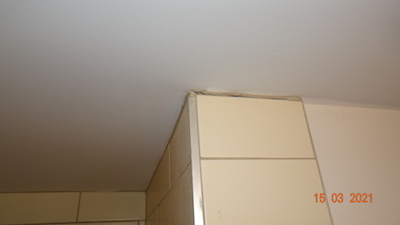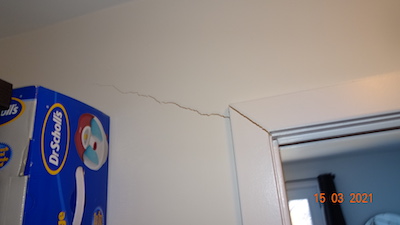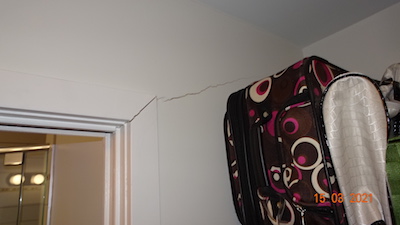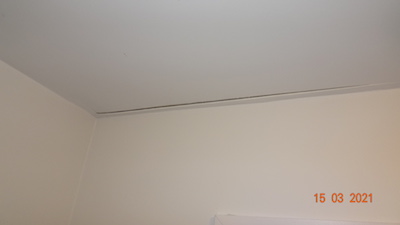Illustration of the day – March 15th, 2021
PROBLEMS WITH CEILINGS – TRUSS UPLIFT
Truss uplift is a cold weather problem that is not terribly serious from a structural standpoint, but is very disturbing to home owners and can cause considerable cosmetic disruption.
Truss uplift occurs in the winter only. It occurs because the bottom chord of the truss arches up. The ends of the bottom chord rest on the outside wall, but the center portion rises. This usually creates a gap between the top of interior partitions near the center of the house and the ceiling. This gap can be well over an inch. In some cases, the partition wall is rigidly attached to the bottom chord of the trusses. In this case, the partition wall may be pulled up and a gap may appear between the bottom of the wall and the floor.
These gaps always look like the wall is dropping (if the gap is at the wall ceiling intersection), or like the floor is dropping (if the gap appears at the wall/floor intersection). This is because we are prisoners of gravity and think that all movement in a vertical plane is down. In this case, however, the movement is up. Either the ceiling is lifting off the wall or the wall is lifting off the floor. Close examination and perhaps the help of a mason’s level will allow you to verify this.
The cause of truss uplift is not perfectly understood. The explanation that makes the most sense to us goes like this.
The cause of the bottom chord arching up is thought to be related to the differential moisture content of the wood framing members in the truss. Let’s look at the different environments the truss components see. In cold climates, the bottom chord of the truss is surrounded by insulation. As a result, it is kept relatively warm. The majority of the webs and the top chords are above the insulation and are in a much colder environment. But temperature differences alone do not explain truss uplift.
Relative humidity is an indication of the amount of moisture in the air relative to the amount the air could possibly hold when it is saturated. Warm air can contain a lot more moisture than cold air. If you take a bundle of air at 70°F and 40% relative humidity, and heat it up, the relative humidity will drop. The amount of moisture in the air stays the same. However, the air is capable of holding much more moisture so at 90°F, the relative humidity might be only 20%.
If you take the same bundle of 70° air at 40% relative humidity and cool it, the relative humidity increases. For example, if you drop the air temperature to about 40°, the relative humidity approaches 100% and you may get condensation. We haven’t added moisture to the air. Simply cooling the air has changed the relative humidity. This is important in understanding truss uplift because wood sees relative humidity.
If the relative humidity is low, no matter what the temperature, wood will not tend to draw moisture out of the air. As a matter of fact, moisture will leave the wood and the wood will become dryer. If the wood is surrounded by air with a high relative humidity, moisture will travel from the air into the wood. Now let’s look at our attic environment.
The bottom chord is in a warm environment. This means that the relative humidity will be low. The air surrounding the bottom chord might be close to 70° and the relative humidity might be 30 to 40%.
The webs and top chords are in a much colder environment, with a much higher relative humidity – perhaps 80%, for example. To put the whole picture together, we need to look at one other thing.
Most of us are comfortable with the concept that wood swells. From the discussion, it’s easy to see that the top chords and webs are going to see more moisture than the bottom chord. As a result, the top chords will want to get longer. They are tightly pinned at the bottom corners. The top chords get longer, and the peak of the roof rises slightly. This pulls the webs up and in turn pulls up on the bottom chord. The bottom chord can’t rise at the wall corners because it’s fixed at the outer edges. As a result, it lifts in the middle. As we discussed, it may lift off the partition walls in the middle of the building or may pick the partition walls off the floor.
Truss uplift occurs in the winter, but as the attic environment changes and the warmer months come, truss uplift will reverse, and the truss will settle back down. The problem repeats itself every winter and corrects itself every summer. The amount of truss uplift may vary depending on weather severity.
Trusses with longer spans and trusses with lower slopes are more likely to suffer. Trusses in well insulated attics are more likely to suffer uplift.
It’s not possible to prevent truss uplift. The more tightly we secure partitions to the bottom chord, the more the house is picked up.
The solutions typically lie in concealing the movement. One approach is to use a molding attached to the ceiling but not to the partitions. As the ceiling is lifted up during truss uplift, the molding simply slides up the wall. This is sometimes successful in masking cosmetic deficiencies, although the moldings will sometimes scratch the wall surfaces, or the raised moldings will reveal paint of a different color or bare spots on wallpapered sections of the wall.
A more recent solution is to allow the ceiling drywall near the center partitions to float. The drywall is not attached to the trusses within roughly 18 inches of the partition walls. The edge of the ceiling drywall is secured to the wall with a 1 by 6 attached to the top plate, or a drywall clip fastened to the top of the wall. When the truss lifts, the edge of the ceiling drywall stays in place since it’s not attached to the bottom chord near the partitions. The drywall bends up over 18 inches to the point where its attached to the trusses.
When looking at truss roofs, understand that their advantage is their long uninterrupted spans and no need for interior bearing walls, but watch for the uplift problem particularly at interior partitions near the center of the truss span. Truss uplift is much easier to see in the winter, when the trusses have moved, than in the summer when they have relaxed.
Look for gaps or evidence of movement at the wall/ceiling intersection and the wall/floor intersection.
Trusses most likely to lift are those with long spans, low slopes and lots of insulation in the attic. It is not a serious structural issue.















